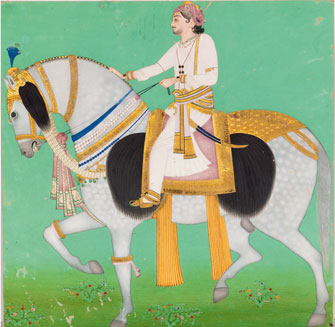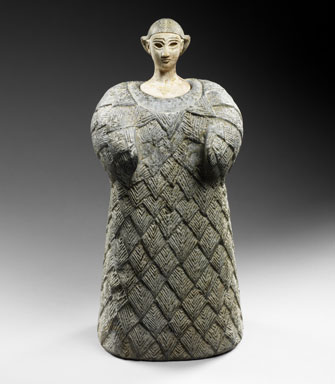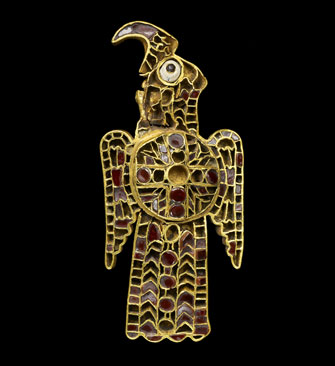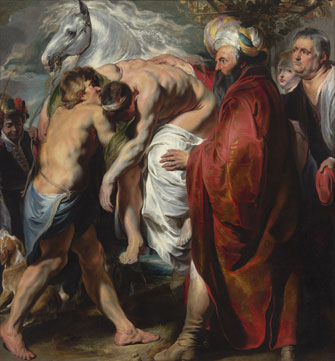On the Road
To Abu Dhabi

Equestrian Portrait of Maharao Sheodan Singh of Alwar India, Rajasthan, Alwar (c. 1863). © Louvre Abu Dhabi/Agence photo F
The new exhibition at the Louvre, “Birth of a Museum: Louvre Abu Dhabi” is a strange amalgam. It is a kind of promotional preview for what is billed as “the first universal museum in the Arab world,” set to open in December 2015 with its own growing collection, supplemented by 10-year loans from several French national museums, including the Louvre. The exhibition also feels like something of an advertisement for its architect, Jean Nouvel, who has designed a handsome white openwork dome that lets dappled light filter down on the collection of variously shaped gallery buildings underneath. At the same time, the show serves as a severely truncated overview of nearly the entire history of art.
It is nevertheless worth seeing for the many magnificent pieces on display, beginning with one of the earliest, a chlorite and calcite statue of a Bactrian princess that is some 5,000 years

Bactrian “Princess.” Central Asia, late third millennium BCE–early second millennium BCE. © Louvre Abu Dhabi/Thierry Ollivier
old. It is followed by such marvels as a late-fifth-century gold fibula in the shape of a stylized eagle decorated with shells and garnets, from Domagnano, Italy; a gorgeous

Eagle-shaped fibula from Domagnano, Italy, late fifth century CE. © Louvre Abu Dhabi/Thierry Ollivier
late-13th-century illuminated Koran from Syria, and an amazingly delicate and expressive small ivory statue of the virgin and child dating from France in the early 14th century, to give just a very few examples.
As the show marches forward in time, it presents everything from a group of intricate Kashan-style lusterware objects from Iran and a lovely selection of miniature paintings from Iran and India to decorative objects from all over, including a wonderful 18th-century rooster in copper alloy from Edo, Benin City, Nigeria, and some of Englishman Christopher Dresser’s proto-Modern designs from the late 19th-century. Paintings take pride of place toward the end, with works by Corot, Gauguin, Caillebotte and more. The show closes with a series of nine large-scale white-on-blue scribble paintings, “Untitled I–IX” (2008), by Cy Twombly, one of the artist’s last big projects before he died 2011.
In some juxtapositions of works, it is clear that comparisons are being made, as in the placement of a large basin with relief carvings from Rome next to early 12th-century Romanesque capitals from Beauville, France. In other cases, however, the message, if there is one – and, as far as I can tell, there often isn’t – is not made explicit.
The best parts of the show, apart from the most beautiful pieces, are the informative animated graphics that compare or explain different works. Some of them show how styles evolved over time and traveled from one culture to another along trade routes or following armies on the move. One explains the meanings of the many symbols that are part of a late-10th-century statue of a dancing Shiva from Tamil Nadu, India. Another compares the painting

“The Good Samaritan” (c. 1616), by Jacob Jordaens. © Louvre Abu Dhabi/Agence Photo F
styles of Jacob Jordaens with his master, Rubens, while yet another shows how Edouard Manet cut up one of his paintings to create three paintings. These are so well done that you wish there were more of them to enhance your understanding of the pieces on show.
You may well think you really are in a museum in Abu Dhabi because of the freezer-strength air-conditioning in the exhibition. Bring a sweater if you wish to stay for a while.
Musée du Louvre: Hall Napoléon. Métro: Palais-Royal-Musée du Louvre. Tel.: 01 40 20 53 17. Open Wednesday-Monday, 9am-6pm (until 9.45pm on Wednesday and Friday). Closed Tuesday, December 25 and January 1. Admission: €13. www.louvre.fr
Click here to read all of this week’s new articles on the Paris Update home page.
Reader Reaction: Click here to respond to this article (your response may be published on this page and is subject to editing).
Support Paris Update by ordering books from Paris Update’s Amazon store at no extra cost. Click on your preferred Amazon location: U.K., France, U.S.
© 2014 Paris Update
Favorite